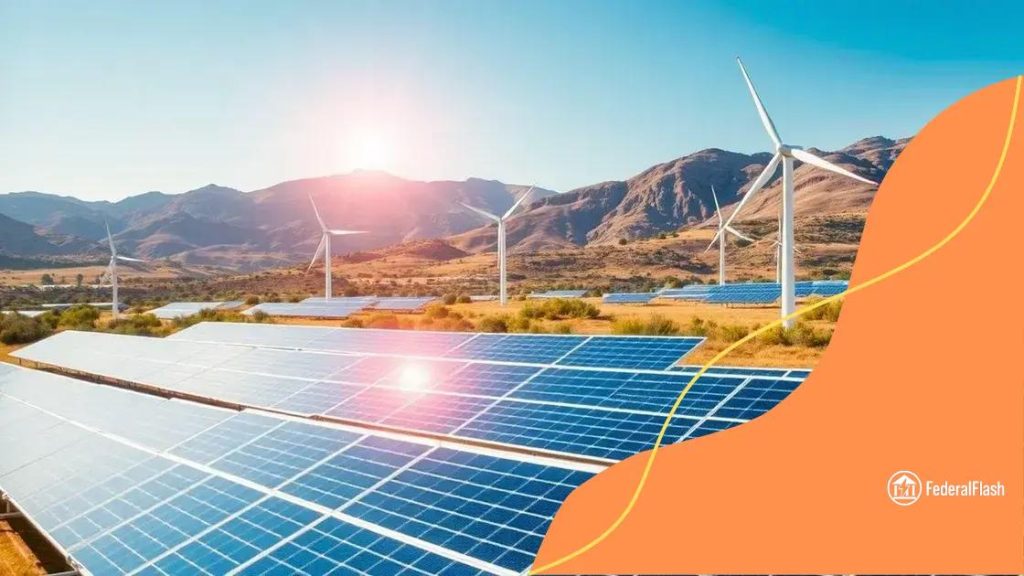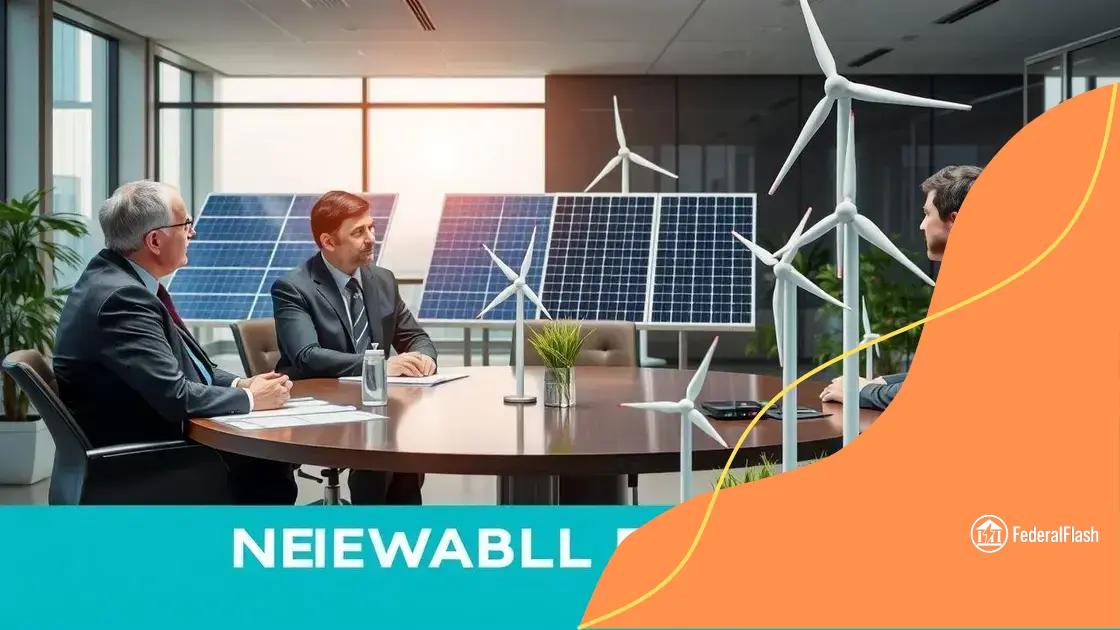Clean energy shift progresses: what to expect next

Anúncios
The clean energy shift progresses by increasing the adoption of renewable energy technologies, supported by government policies, leading to job creation, economic growth, and a healthier environment.
The clean energy shift progresses at a remarkable pace, influencing how we generate and consume energy. With growing urgency around climate change, it makes sense to explore what this means for our future and daily lives. Are you ready to understand the changes ahead?
Anúncios
Overview of clean energy shift
The clean energy shift has become a vital part of our global strategy to combat climate change. It represents a significant movement away from fossil fuels towards renewable energy sources like solar, wind, and hydroelectric power.
Understanding this shift involves looking at the key factors contributing to the change. Several environmental, economic, and technological influences are driving this transition.
Key Factors Influencing the Clean Energy Shift
Many aspects are crucial in reshaping how we think about energy production:
Anúncios
- Technological advancements: Innovations in renewable technologies have made clean energy more cost-effective.
- Environmental concerns: Growing awareness of climate change urges us to reduce greenhouse gas emissions.
- Policy changes: Governments are introducing policies that promote and sometimes mandate the use of renewable energy.
- Consumer demand: Individuals and businesses are increasingly seeking sustainable energy options.
As these factors intersect, they create a robust framework for transitioning to clean energy sources. The cultural shift towards sustainability is also notable. People are becoming more aware of their energy consumption and its impact on the environment.
To support this movement, communities worldwide are investing in local renewable projects, further enhancing the clean energy landscape. These projects not only help reduce dependence on fossil fuels but also create jobs and stimulate local economies.
The Role of Renewable Energy Sources
Different renewable energy sources each contribute uniquely to this transition. For example, solar energy harnesses the sun’s power, while wind energy captures air movement. Together, they form a diverse energy portfolio that helps ensure a stable supply.
Ultimately, as we embrace this clean energy shift, the growth of knowledgeable consumers and informed policymakers will help guide our future. It is clear that our energy landscape is evolving.
Key technologies driving the change
Many key technologies are driving the change towards renewable energy. These advancements are crucial for making clean energy more accessible and efficient.
Among these, solar and wind technologies stand out. Solar panels capture sunlight and convert it into electricity, while wind turbines harness air movement to generate power. These two sources are essential components of the energy transition.
Innovations in Solar Technology
New developments in solar technology make it possible to create more efficient panels. This includes:
- Solar photovoltaic (PV) cells: These cells convert sunlight directly into electricity.
- Thin-film solar cells: They are lightweight and flexible, allowing for various applications.
- Concentrated solar power: This system uses mirrors to focus sunlight, generating heat to produce electricity.
As solar technology continues to evolve, the potential for reducing costs and increasing output becomes greater, making it a vital player in the clean energy shift.
Advancements in Wind Energy
Wind energy is also seeing exciting innovations. For instance, improved turbine designs help capture more energy efficiently. Key factors include:
- Offshore wind farms: These capture stronger and more consistent winds, generating more power.
- Smart technology: Turbines equipped with sensors can adjust to changing wind conditions.
- Smaller, distributed turbines: These can be installed in various locations, bringing energy closer to consumers.
As these technologies develop, they create a more robust infrastructure for clean energy, resulting in reduced reliance on fossil fuels.
Battery storage technology is another critical element. It enables the storage of excess energy generated from renewable sources for later use. This helps to balance supply and demand, making energy more reliable.
As we continue to innovate and improve these key technologies, the transition to renewable energy sources becomes easier and more sustainable, paving the way for a brighter, cleaner future.
Government policies supporting clean energy

Government policies play a crucial role in supporting the clean energy transition. By implementing favorable regulations and incentives, governments can significantly influence the growth of renewable energy resources.
One major area of focus is financial incentives. Many governments offer tax credits and rebates for homeowners and businesses that invest in renewable technologies. This encourages more people to adopt solar panels and wind turbines.
Types of Government Support
There are various ways governments can support clean energy initiatives:
- Subsidies: Direct financial assistance to renewable energy projects helps lower costs and encourages investment.
- Renewable Energy Standards: Mandates for electricity providers to obtain a certain percentage of their energy from renewable sources drive demand.
- Grant Programs: Funding for research and development accelerates innovation within the clean energy sector.
- Public Awareness Campaigns: Educating citizens about renewable energy benefits promotes community-wide adoption.
Through these measures, governments create a supportive environment that fosters innovation and growth in the clean energy market. The transition can also be enhanced by international agreements focused on reducing carbon emissions.
For example, agreements like the Paris Agreement encourage countries to set goals and collaborate on sustainability efforts. By working together, they can share technologies and resources, amplifying their impact.
In addition to international efforts, local policies can also make a difference. Municipalities can establish clean energy programs tailored to their unique needs and resources. This localized approach helps communities become more resilient and sustainable.
Overall, as governments continue to back clean energy initiatives, we will see a more significant shift towards renewable sources. This support is essential for achieving long-term climate goals and fostering a sustainable future.
Impact on job markets and economies
The impact on job markets and economies due to the clean energy shift is substantial. As more resources are allocated to renewable energy, new opportunities arise across various sectors.
Initially, there are challenges as fossil fuel industries begin to decline. However, this transition creates a demand for skilled workers in clean energy fields. For example, solar panel installers and wind turbine technicians are in high demand.
Job Creation in Renewable Energy
Here are some significant areas where jobs are being created:
- Installation: Workers are needed to install solar panels and wind turbines.
- Maintenance: Technicians maintain and repair renewable energy systems, ensuring they operate efficiently.
- Research and Development: Scientists and engineers innovate to improve energy technologies.
- Project Management: Coordinators are needed to oversee renewable energy projects from start to finish.
As these jobs grow, communities benefit from increased employment opportunities. Many programs and initiatives are aimed at training workers for these new roles, making education in clean energy technologies essential.
Furthermore, the shift to renewables positively influences local economies. By investing in clean energy projects, communities can foster sustainable growth. Renewable energy often leads to lower energy costs over time, benefiting households and businesses. The savings can then be reinvested in local economies, spurring additional job creation.
Economic Resilience
Another key aspect of this transition is enhancing economic resilience. Communities that invest in renewable energy can reduce their dependence on imported fossil fuels. This shift leads to a more stable energy market, less susceptible to price fluctuations.
In conclusion, the movement towards renewable energy not only drives job creation but also promotes economic growth and resilience. Communities that embrace this change are poised to thrive in a sustainable future.
Future trends in renewable energy
The future trends in renewable energy are exciting and full of potential. As technology evolves and society shifts towards sustainability, several key areas are likely to grow.
One major trend is the rise of energy storage solutions. As the demand for renewable sources increases, so does the need to store excess energy. Innovations in battery technology, like lithium-ion batteries, are making it possible to store energy more efficiently.
Integration of Smart Technology
Using smart technology will also shape the future of renewable energy. Smart grids allow for better management of energy distribution. This technology helps balance supply and demand, making renewable energy sources more reliable.
- Smart meters: These devices provide real-time data to consumers about their energy usage.
- Automated systems: They help manage energy distribution effectively, responding to changes in demand.
- Data analytics: Using data to optimize energy use and improve sustainability.
As homes and businesses adopt smart technologies, the efficiency of renewable energy systems is expected to improve significantly.
Decentralization of Energy Production
Another trend to watch is the decentralization of energy production. More individuals and communities are generating their own energy through solar panels and small wind turbines. This shift leads to greater energy independence and less reliance on traditional utility companies.
Additionally, community solar projects are gaining popularity. These initiatives allow groups of people to invest in a shared solar energy source, benefiting all participants. This model enhances access to renewable energy for those who may not have suitable roofs for solar installations.
Finally, the importance of sustainable practices in production cannot be overstated. Businesses are increasingly recognizing the need to adopt sustainable practices in all operations. This includes using renewable energy sources in their manufacturing processes, which helps reduce their carbon footprint.
The combination of these emerging trends points to a bright future for renewable energy. As society continues to innovate and prioritize sustainability, it is clear that renewable energy will play a significant role in our lives.
FAQ – Frequently Asked Questions about Clean Energy Transition
What is the main benefit of transitioning to clean energy?
The main benefit is reducing greenhouse gas emissions, which helps combat climate change and fosters a healthier environment.
How does clean energy impact job markets?
The shift to clean energy creates new job opportunities in installation, maintenance, and research, boosting local economies.
What technologies are driving the clean energy change?
Key technologies include solar panels, wind turbines, energy storage solutions, and smart grid systems that improve efficiency.
How can individuals contribute to the clean energy movement?
Individuals can install renewable energy systems like solar panels, support clean energy policies, and make conscious energy choices.